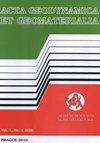Geotechnical performance of combined stone columns and piles capped with reinforced concrete raft foundation in soft clay soil
IF 0.8
4区 地球科学
Q4 GEOCHEMISTRY & GEOPHYSICS
引用次数: 0
Abstract
Stone columns consist of granular material compacted in long cylindrical holes. They are used for improving the strength and consolidation characteristics of compressible soils. However, they are still less effective at supporting heavy loads, since they still cannot transfer applied stresses to deeper layers of soil. The main objective of this numerical study was to investigate the geotechnical performance of a combined foundation system composed of stone columns and piles grouped together under a rigid raft foundation in compressible soil. The failure mechanism of this hybrid foundation system was examined, and configurations optimizing the performance of the combined foundation system were explored. An analytical model was developed for predicting the ultimate carrying capacity of the combined system in compressible soils. It was deduced that combining stone columns and piles in one foundation system improved considerably the system’s carrying capacity. Moreover, the uppermost improvement was observed when the piles were installed on the periphery or edge of the raft foundation, while stones columns were placed at the center area of the raft. The failure of the combined foundation system started from the center of the raft and noticeably extended to its edges. Due to the presence of stone columns in the combined foundation system, the piles did not interact. The areas affected or influenced by the soil–pile interaction also did not overlap.软粘土地基中钢筋混凝土筏板承台组合桩的岩土力学性能
石柱由长圆柱形孔中压实的颗粒材料组成。它们用于改善可压缩土壤的强度和固结特性。然而,由于它们仍然不能将施加的应力传递到更深的土壤层,因此它们在支撑重载时的效果仍然较差。本数值研究的主要目的是研究可压缩土中刚性筏板基础下由圆柱和桩组成的组合地基系统的岩土性能。研究了这种混合地基系统的破坏机理,并探讨了优化组合地基系统性能的配置。建立了可压缩土中组合系统极限承载力的分析模型。结果表明,在一个基础体系中,将碎石桩与桩组合,可显著提高该体系的承载力。此外,当桩安装在筏板基础的外围或边缘时,观察到最显著的改善,而立柱则放置在筏板的中心区域。组合基础系统的故障从筏板的中心开始,并明显延伸到其边缘。由于组合地基系统中存在立柱,因此桩之间没有相互作用。受土-桩相互作用影响或影响的区域也没有重叠。
本文章由计算机程序翻译,如有差异,请以英文原文为准。
求助全文
约1分钟内获得全文
求助全文
来源期刊

Acta Geodynamica et Geomaterialia
地学-地球化学与地球物理
CiteScore
2.30
自引率
0.00%
发文量
12
期刊介绍:
Acta geodynamica et geomaterialia (AGG) has been published by the Institute of Rock Structures and Mechanics, Czech Academy of Sciences since 2004, formerly known as Acta Montana published from the beginning of sixties till 2003. Approximately 40 articles per year in four issues are published, covering observations related to central Europe and new theoretical developments and interpretations in these disciplines. It is possible to publish occasionally research articles from other regions of the world, only if they present substantial advance in methodological or theoretical development with worldwide impact. The Board of Editors is international in representation.
 求助内容:
求助内容: 应助结果提醒方式:
应助结果提醒方式:


